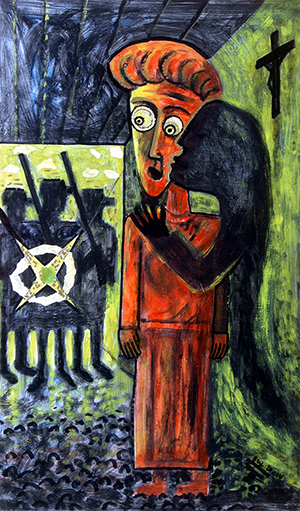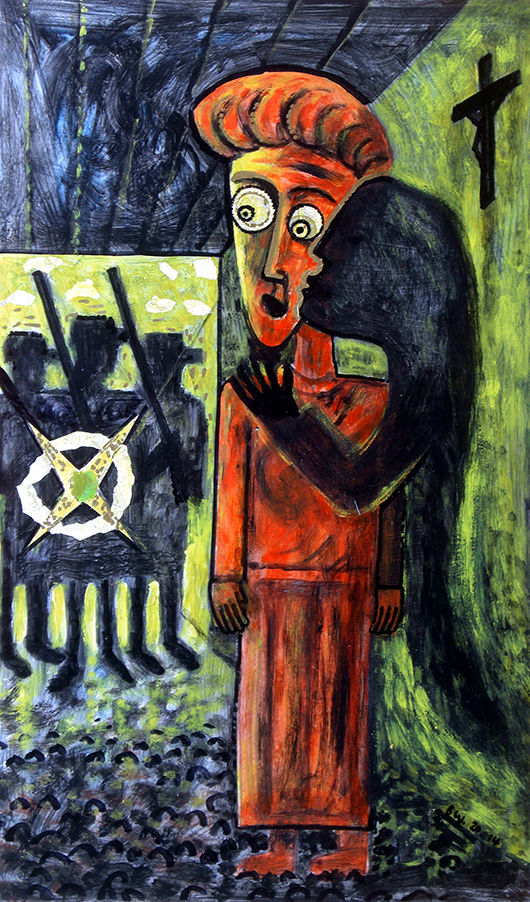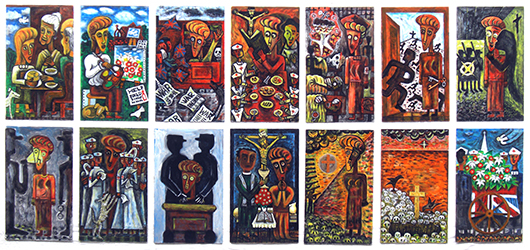
“I am left exiled and destitute in an alien land, where there are daily wars and dreadful disasters. Give me comfort … and calm my grief.”
Artist Brian Whelan was so struck by Cavell’s love of the sacred tract that he painted its medieval author, quill in hand, into the background of a new painting about Cavell’s life.
The work, titled Imitation, is one of 14 Whelan paintings in a small but compelling exhibit at Washington National Cathedral that retells the story of Cavell’s “martyrdom” during the war.
Scarcely remembered in the United States today, Cavell’s execution was a sensation in its time. One British newspaper called it “the most damnable crime of the war.” Another termed it “foul … infamy.”
“It is a deed which … stuns the world, and cries to Heaven for vengeance,” declared another.
Her death, a century ago next year, is said to have helped tip the United States toward entering the war. Scores of children – as well as a mountain in Canada, a racehorse and a kind of rose – were later named after Cavell.
The exhibit, which marks the centennial of World War I, opened July 24 and runs through Sept. 18. It is the paintings’ public debut.
Cavell, whose name rhymes with “travel,” was 48 and the head of a nursing school in Brussels when Germany invaded Belgium in 1914.
While caring for victims on all sides of the conflict, she also helped scores of Allied soldiers escape capture.
When German officials found out, they put her on trial and had her shot on Oct. 12, 1915.
Two years ago, Whelan, 57, who was born in London to Irish parents and is known for his colorful, post-modern religious paintings, said he was approached by two British clergymen from Norwich Cathedral, where Cavell is buried.
With the centennial of the 1914-1918 war, would he consider painting a commemoration of her for the British cathedral?
Whelan, who now lives in the Washington area, was hesitant. He recalled Cavell more as a historical than a religious figure.
“I was very aware of her as being buried deep under an awful lot of war propaganda … and Edwardian sentimentality,” he said in an interview at Washington National Cathedral this month.
“I was a little wary,” he said. “I thought, ‘I’ve got to find a new way of approaching her.’”
Eventually, he produced five paintings of different aspects of Cavell’s life and showed the clergymen. They were intrigued, he said.
“‘This is exactly what we need,’” he said one told him. “They were very keen that I developed the spiritual side of her.”
He did nine more – with acrylic paint and acrylic varnish on a wooden board.
The paintings, finished this year, are intimate and crammed with color and figures. They portray Cavell as a solitary person of faith rather than the victim of an atrocity.
They include depictions of the prim Cavell with an exaggerated wedge-shaped face, large round eyes and a mound of upswept hair.
The paintings include dogs, doves, a crucified Christ, an open grave rimmed with skulls and a delicate cross fashioned with foil from a chocolate wrapper.
“You can get some amazing colors,” he said of the orange foil bearing the name “Galler,” a Belgian candy company. He said fans mail him foil wrappers, knowing that he uses the foil in his art.
The Cavell paintings make up a narrative, he said. They show her as war is declared, as she is working with skeletal wounded soldiers wrapped in blankets and as she helps men escape.
They depict her betrayal by a ghostly, Judas-like figure, her arrest, trial and execution, and her funeral in England after the war.
At first glance, the vibrant energy of the paintings seems unsuited for the somber confines of a cathedral. And Whelan said some of his other religious work has been viewed as “cheeky.”
But the Cavell work hints at medieval art, which Whelan loves, and is filled with Christian symbolism.
“Each person’s got their own reaction to the work,” he said. “And it’s as valid as anybody else’s, including the artist.”
Whelan said he did the paintings at a house his wife owned in the Blue Ridge Mountains in Bluemont, Loudoun County, in Virginia.
Once they were finished, he said, he began looking for a place to exhibit them before they are installed at Norwich Cathedral at Easter.
He approached Washington National Cathedral, which had been looking for a way to mark the centennial of the start of World War I. The cathedral holds the tomb of the wartime president, Woodrow Wilson.
The paintings seemed perfect. “Not only was (Cavell) a great humanitarian, she was a devout Christian,” said Ruth Frey, director of programs at the cathedral. She said that like many Americans, she did not at first know who Cavell was.
But researching her, “I just felt like I opened up this little historical treasure trove,” Frey said in a telephone interview.
It “was an exciting thing to learn about her and her courage and compassion and the impact that she had on, really, the whole world at that time,” she said.
The day before her execution, according to biographer Helen Judson, Cavell wrote from Brussels’s Prison de Saint-Gilles to a troubled young friend she had been mentoring:
“My dear Girl …
“If God permits I shall still watch over you and … wait for you on the other side. Be sure to get ready for then. I want you to know I was neither afraid nor unhappy, but quite ready to give my life for England. …
“Only remember that I love you and love you still.
“Edith Cavell.”
___
Information from: The Washington Post, http://www.washingtonpost.com
Copyright 2014 Associated Press. All rights reserved. This material may not be published, broadcast, rewritten, or redistributed.
AP-WF-08-24-14 1423GMT
ADDITIONAL IMAGES OF NOTE



